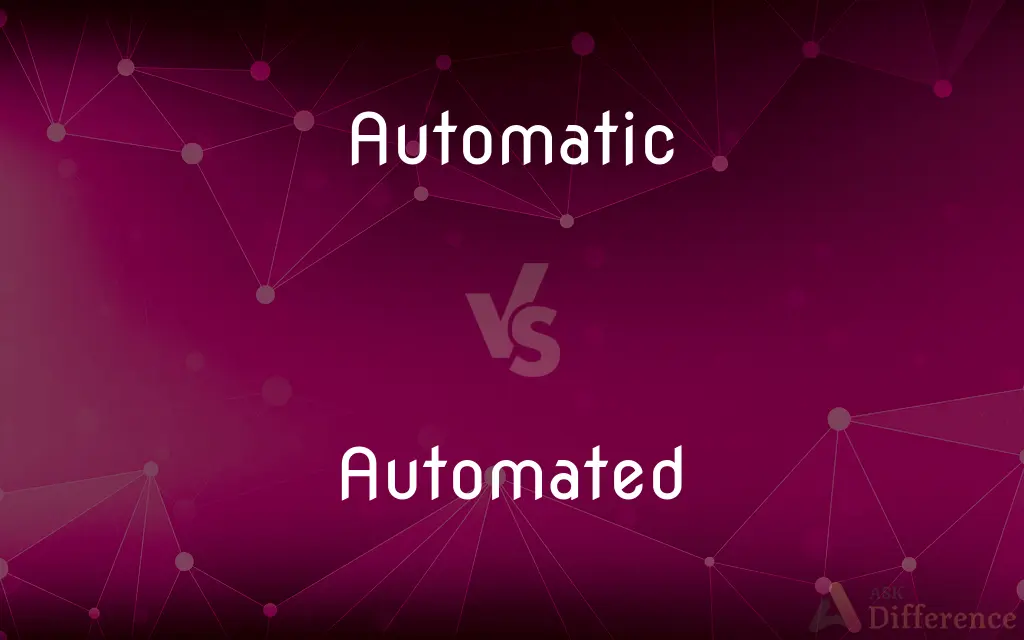Automatic vs. Automated — What's the Difference?
By Fiza Rafique & Maham Liaqat — Updated on February 22, 2024
Automatic processes operate without human intervention, often based on pre-set mechanisms, while automated systems are designed to perform tasks autonomously using technology or machinery, typically programmed to respond to varying conditions.

Difference Between Automatic and Automated
Table of Contents
ADVERTISEMENT
Key Differences
Automatic refers to machinery or systems functioning independently once activated, without ongoing human control. These processes rely on mechanical or simple electronic principles to operate consistently under the same conditions. Automated, on the other hand, implies a level of sophistication involving computers or robots to perform tasks, often with the ability to adjust operations in response to different inputs or environments, such as an automated manufacturing line that can adapt to produce different products.
Automatic systems are usually straightforward, with specific functions that continue without needing external input once initiated. These might include devices like automatic doors that open when triggered by a sensor. Automated systems incorporate technology to make decisions based on programming, algorithms, or artificial intelligence, allowing for a broader range of functions and adaptability, like an automated drone navigating obstacles.
The distinction also lies in the complexity and adaptability of the systems. Automatic mechanisms are typically designed for singular or limited tasks with consistent execution, whereas automated systems can be reprogrammed or configured to undertake varied tasks, making them more flexible and adaptable to changing needs or conditions.
In terms of application, automatic systems are often found in consumer products and simple machinery, providing convenience and efficiency without manual input. Automated systems, however, are integral to industries such as manufacturing, logistics, and information technology, where they enhance productivity, accuracy, and the ability to scale operations.
This delineation highlights the evolution from automatic to automated systems, showcasing a shift from mechanical ingenuity to the integration of digital technology, which has expanded the possibilities for innovation and efficiency in various fields. Both play crucial roles in modern life, but automated systems represent a leap forward in terms of complexity, capability, and the potential for future advancements.
ADVERTISEMENT
Comparison Chart
Definition
Mechanisms or processes operating independently of human intervention based on pre-set operations.
Systems designed to perform tasks autonomously using technology, capable of adapting to new conditions.
Key Features
Simple, consistent operation; limited adaptability.
Complex, adaptable, can be reprogrammed for different tasks.
Human Intervention
Minimal to none after activation.
Minimal; involves monitoring or reprogramming rather than direct control.
Complexity
Generally lower, with straightforward functionality.
Higher, incorporating advanced technology and programming.
Applications
Common in consumer products and basic machinery.
Widely used in manufacturing, logistics, and IT for scalability and efficiency.
Compare with Definitions
Automatic
Operates independently once initiated.
The automatic gate opens when a car approaches.
Automated
Performs tasks autonomously using advanced technology.
An automated assembly line adjusts to manufacture different products.
Automatic
Simple mechanical or electronic operation.
Automatic watches wind themselves as the wearer moves.
Automated
Incorporates programming or AI for adaptability.
Automated customer service bots provide tailored responses to inquiries.
Automatic
Requires no human intervention to maintain function.
An automatic sprinkler system waters the garden at set times.
Automated
Enhances productivity and efficiency through technology.
Automated inventory systems track and reorder stock as needed.
Automatic
Limited to specific, unchanging tasks.
An automatic coffee machine brews coffee at the press of a button.
Automated
Used in complex applications requiring flexibility.
Automated drones navigate and adjust flight paths autonomously.
Automatic
Predetermined actions based on specific triggers.
Automatic lights turn on at dusk.
Automated
Can be reconfigured or reprogrammed for various tasks.
Automated software testing tools adapt to test different applications.
Automatic
Acting or operating in a manner essentially independent of external influence or control.
An automatic light switch.
A budget deficit that triggered automatic spending cuts.
Automated
To convert to automatic operation.
Automate a factory.
Automatic
Having an inherent power of action or motion.
Nothing can be said to be automatic.
Automated
To control or operate by automation.
Automatic
A transmission or a motor vehicle with an automatic gear-shifting mechanism.
Automated
Done by machine.
Automatic
Not voluntary; not depending on the will; mechanical; controlled by the autonomic nervous system; without conscious control; as, automatic movements or functions. The opposite of voluntary.
Unconscious or automatic reasoning.
Common Curiosities
What is an automatic system?
An automatic system operates on its own after being activated, performing consistent, pre-determined tasks without human intervention.
How do automatic and automated systems differ in complexity?
Automatic systems are generally simpler and perform consistent tasks, while automated systems are more complex, incorporating technology to adapt to various tasks.
What is an automated system?
An automated system uses technology and programming to perform tasks autonomously, capable of adapting its operations based on different inputs or conditions.
Why are automated systems preferred in industries like manufacturing?
Their ability to adapt, scale, and perform complex tasks with high precision makes them ideal for enhancing productivity and operational efficiency in such sectors.
Can automation lead to job displacement?
While automation can replace certain manual tasks, it also creates opportunities for new roles focused on system design, maintenance, and oversight.
How do automatic and automated systems impact efficiency?
Both improve efficiency, but automated systems offer greater scalability and flexibility, making them more effective in complex or changing environments.
What role does human intervention play in automated systems?
Human intervention in automated systems is usually limited to monitoring, maintenance, and reprogramming, rather than direct control during operation.
How does the use of automated systems affect product quality?
Automated systems can improve product quality through consistent application of standards and reducing human error.
Can automatic systems adapt to new conditions?
No, automatic systems operate based on fixed conditions and cannot adapt to new situations without human modification.
Are automated systems always digital or computer-based?
While not exclusively, most modern automated systems involve digital technology or computers to achieve flexibility and adaptability in their operations.
Can an automatic process become automated?
Yes, with the addition of technology and programming, an automatic process can be upgraded to an automated one, enhancing its adaptability and functionality.
How do advancements in AI influence automated systems?
AI advancements enhance the intelligence, decision-making capabilities, and adaptability of automated systems, expanding their applications and effectiveness.
Can automation improve safety in workplaces?
Yes, by performing dangerous or repetitive tasks, automation can reduce workplace accidents and improve overall safety.
What is the future of automatic and automated systems?
The future likely involves increasingly sophisticated automation with advanced AI, improving efficiency, adaptability, and the ability to perform complex tasks autonomously.
Are there ethical considerations in the deployment of automated systems?
Yes, ethical considerations include the impact on employment, privacy concerns, and the need for equitable access to the benefits of automation.
Share Your Discovery

Previous Comparison
Joule vs. Calorie
Next Comparison
Lumber vs. TimberAuthor Spotlight
Written by
Fiza RafiqueFiza Rafique is a skilled content writer at AskDifference.com, where she meticulously refines and enhances written pieces. Drawing from her vast editorial expertise, Fiza ensures clarity, accuracy, and precision in every article. Passionate about language, she continually seeks to elevate the quality of content for readers worldwide.
Co-written by
Maham Liaqat














































